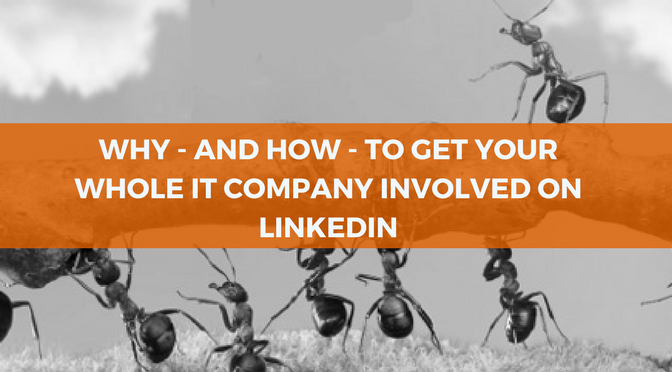Why – and How – to Get Your Whole IT Company involved on LinkedIn
Most of our clients invest in LinkedIn marketing programs to generate and develop leads. A few of them are more focused on establishing thought leadership positions. Ultimately, both groups have the same objective. They want to influence their buyers’ decision making.
Your LinkedIn efforts are much more powerful when you involve your entire company.
Take a look at your marketing / sales process. I’ll go out on a limb here and bet it takes a team. Your top sales person may close the big deals but multiple people contribute to making it happen. LinkedIn gives you an opportunity to involve these people even earlier in the buying process, which often has the much-desired benefit of speeding up the buying decision.
To paraphrase Kevin Kelly, Founding editor of Wired Magazine:
Nobody is as influential as everybody.
Who should be on your LinkedIn team?
Every employee can help you increase visibility but some employees are naturally more valuable to your LinkedIn program. These include:
Technical people. A recent IDC study, the 2012 IT Buyer Experience Survey (download here), found that technical sales teams are the most highly valued source of information for IT buyers. So get them out there and let them interact.
Industry and subject matter experts. Your product solves a business problem. Your LinkedIn team should include someone(s) who deeply understand these problems and can lead prospect out of the quagmire. One large enterprise software company is building an extensive LinkedIn program around its lead consultants with the goal of ensuring customers and prospects want to hear from them and actively seek them out.
Visionaries. Whether it’s cloud computing, virtualization, optimization or whatever, IT buyers are often deeply interested in where technology and/or business is headed and how your solutions fit in. Your ability to provide thought leadership in these areas helps tremendously in getting buyers to know, like and trust you.
Product management. LinkedIn provides a great opportunity for product management to interact directly with more prospects and customers, and provide answers to their questions more quickly than going back and forth through a sales person. This includes questions about the product road map as well as the “facts” about the current capabilities of an existing product.
Service / Support / Implementation experts. These folks are intimately familiar with your solution in action and can provide answers to “what if” questions as well as solving problems before they become critical.
Executives. Executives serve two purposes in your LinkedIn program. First, they can connect and interact with other executives that might be difficult for others in your company to get to. Second, many buyers like “knowing” the CEO.
Sales people. Naturally, your LinkedIn team is going to include members of your sales staff. After all, your ultimate goal is generate sales opportunities. Your LinkedIn program, properly designed and implemented, will create opportunities for your sales people to connect with buyers.
Everyone. Board members, advisors, investors, employees – each of these help you increase your visibility by involving their own networks.
Depending on your current program objectives, members of your team may come and go in terms of relevance to a program. For example, one client, a global IT company, has built a high-level thought-leadership position that it augments with regional sales participation in conjunction with whatever other marketing campaigns are currently running.
Larger companies may have an advantage because they have more specialists to participate, but any company will benefit from spreading the job of helping buyers make the right decisions.
How to get your team involved on LinkedIn
Naturally, you can’t just select your team and turn them loose on LinkedIn unguided. You need a plan – and you need to make it easy for them to participate. Here are four things you can do to ensure your people and your program are successful on LinkedIn.
Update their profiles. I’ve written before about how critical it is to replace the ubiquitous “resume” style profile with one that is a powerful marketing and sales tool. The profile is often what buyers use to decide whether or not it’s worth connecting with someone, and each person on your team needs a profile that gives the buyer the benefits of connecting. You can read more about LinkedIn profiles here.
Provide status updates for your team to post. To take advantage of your team’s individual networks, you want them to post regular status updates each time you start a new discussion or post new content such as a blog article. But don’t just ask them to post an update. Tell them what to say. You’ll get much better cooperation, believe me.
Find appropriate groups for team members to join and encourage them to be active in those groups. The best way to encourage participation is to begin by monitoring the groups yourself and letting your team member know when there is a good opportunity to comment on a discussion. Over time, many will come to enjoy the interaction and monitor it for themselves.
Create your own LinkedIn group. I can’t overemphasize the value of having your own LinkedIn group. This is the second most powerful thing you can do to ensure success on LinkedIn – right after upgrading profiles. Your LinkedIn group provides a place for your team to send potential buyers to meet others on your team and also a place for interaction on topics you control.
Can you meet your objectives on LinkedIn by yourself? Maybe. But you expand your ability to harness the power of LinkedIn exponentially when you involve a team.
If you want to know more about how to influence IT buyers on LinkedIn, listen in on my phone interview with Mike Weir, LinkedIn's Global Head of Technology Market Development. He'll share a number of moves you can make to ensure your team is on the vendor short list. Click here to access the recording.

